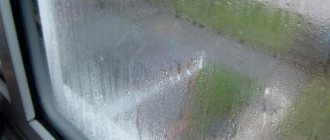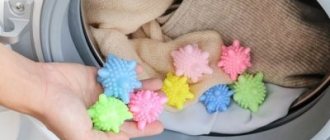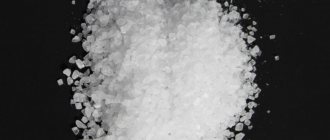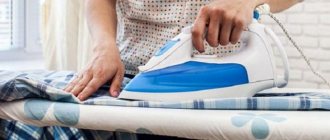Proper drying of things will not only preserve the appearance of clothes and extend their service life, but will also help avoid the formation of mold indoors, as well as health problems!
Thanks to modern washing machines, laundry comes out with a good spin, so drying time is significantly reduced. But the question of how to quickly and correctly dry things always remains relevant in damp and cold weather, especially indoors in an apartment or house. It often happens that you need to dry something very quickly. But here it is important to choose the optimal drying method for each item of clothing, depending on the material. And this article will help you figure out how to quickly dry things without harming them and your health!
How to dry things in an apartment: what to pay attention to?
Home dryers have a variety of designs.
Basic rules on how to dry things in an apartment or house:
- Use a special rack for linen.
- Hang clothes according to the principle: hang small and quick-drying items inside, and large or thick fabric items outside.
- Don't leave clothes in the washing machine for too long, especially overnight. Otherwise, it will begin to acquire an unpleasant musty smell.
- Use a softener. But do not use it on membrane fabrics, wool or microfiber cloths.
- Keep in mind that only warm air can absorb enough moisture. Therefore, you need to dry things only in a warm, heated room.
- Make sure you have enough fresh air. Ventilate the room with wet things more often. Otherwise, it may lead to mold growth due to high humidity.
- Do not wash too much laundry at once and do not dry it in the apartment at the same time.
- Some types of fabric cannot be hung. Otherwise, they may become deformed and stretched.
Storage recommendations
In the summer, clean and ironed wool clothes should be carefully stored in a closet or put in cardboard boxes, taking care to protect them from moths. You should not hang woolen sweaters on hangers to prevent them from stretching out.
For pleasant aromatization and protection from moths, sachets with lavender or chestnuts should be placed on the shelves. Special tablets and strips soaked in lavender oil are effective.
How to properly dry knitted items after washing in an apartment without a balcony: description
Options
There are rules for drying knitwear:
- It is best to dry knitted items on a flat, horizontal surface, on a clean bath towel.
- On the dryer, knitwear can only be laid out on the thick part. Drying on a thin part causes kinks and faster wear.
- At the same time, make sure that the product is as straight as possible, without folds or creases. Otherwise, this will complicate the ironing process and reduce the performance properties of the fabric.
- Do not dry these items using stationary radiators or heaters. This leads to loss of appearance.
- Never dry knitwear in direct sunlight as it will fade quickly.
- Knitted items should not be dried in a dryer as the heat will damage the material and destroy the fibres.
- Knitwear made from nylon or acrylic thread should not be wrung out in the drum of a washing machine - it will be difficult to iron the items.
- Also, do not forget that the key to proper drying is proper washing. Do not fill the drum to maximum. Loose washing stretches knitted underwear less.
Tip: If the knitted product is stretched or deformed, then immerse this area in hot water. The heat compresses the fibers back. Or you can use an iron, stroking and stretching the deformed area with your hands. But this must be done through gauze. And to avoid stretching of the knitwear near the buttons, sew them with loops before washing. After complete drying, open the seams.
Drying tips
You cannot dry woolen items in a vertical position, hanging on a rope, because they will stretch and lose their appearance. You shouldn't use clothespins either - they leave marks. Knitted clothes are dried laid out horizontally in a carefully straightened form. There is no need to stretch the product.
You should allocate a place for drying on the table or floor and cover it with a piece of thick film. Place a thick towel and a woolen product on top. Exposure to sunlight and thermal air from heating sources should be avoided. When pulled over pillows or bolsters, the shape of things is distorted.
Interesting fact! Animal hair, which is used to make woolen items, is similar to human hair. Therefore, care for wool products can be carried out with hair washing preparations. Clothes will become much softer and more tender after rinsing with the addition of hair conditioner, which is easy to verify.
Is it possible and how to dry things on an oil heater?
An oil heater is popular among many residents for additional heating of an apartment or house. And the first thing you need to understand is that it is not intended to dry things on it!
Why you shouldn't use it as a clothes dryer:
- Wet things, as in the case of a heating radiator, prevent radiated heat from escaping into the room
- Things get very dry on the heater
- If you cover the grill through which air escapes, you can cause the heating element to overheat. And this will lead to damage to the device itself.
- If the radiator shut-off sensors are broken, then do not clutter it with wet clothes
- But due to the triggering of sensors, drying clothes may not be as effective. After all, the device turns off for cooling on average after about 20 minutes.
But this is still a solution for those cases when you urgently need to dry certain clothes. After all, batteries do not heat up as much as heaters. Even taking into account the periodic shutdown of the device for cooling, things on the heater will dry many times faster.
It is important not to block air circulation
The main advantage of drying things on an oil heater: The heaters themselves, in principle, greatly dry out the air. Therefore, it is worth placing a container of water or a damp towel on it or nearby. And if you dry things on a heater, the humidity in the room will normalize itself!
Advice: Taking into account technical and fire safety, it would be rational to use a special dryer, which is mounted on top of the radiator. On it, things will dry quickly from the heat of the heater, without blocking the normal air circulation.
When drying things on a heater, you should follow some rules:
- Use only a serviceable and intact heater, without traces of rust.
- To avoid causing corrosion, do not hang items immediately after washing.
- Never cover the air circulation grille!
Important: But don’t be scared – oil heaters don’t explode! In the event of a breakdown, the heating element may burn out or hot oil may leak.
Device
Features of sweaters, blankets and other products made from camel, sheep and other wool
Wool is a natural organic material that is obtained from the hair of various animals.
Finished wool products can be produced:
- from goat hair - mohair, cashmere;
- llama, alpaca, vicuna wool;
- camel hair;
- different types of sheep - merino, first-shorn lamb wool, etc.
Each type of fabric has its own characteristics. They are determined by the type of production of a particular type, the presence of synthetic additives, the manufacturing method, and the cut of the finished product.
How and what items to dry in the dryer: what items should not be dried in the dryer after washing?
You should absolutely not tumble dry:
- Items made from very thin fabrics (tulle, cambric)
- Nylon
- Lace underwear
- Knitted items
- Clothes with embroidery and appliqués
- And also with metal decorations or details
- Products that dry unevenly. For example, pillows, down jackets
Important: It is worth considering the model and brand of the dryer, since each has its own set of programs. Some dryers have features for drying feather items. And some machines allow a combination of programs, for example, extra drying and “warm air blowing”. And still others can completely ruin the down jacket.
The key to proper drying is choosing a program!
How to dry things in the dryer:
- You need to sort by type of fabric, because each type has its own program
- All buttons and hooks must be fastened and laces tied
- To prevent small items from getting inside the duvet cover or pillowcase, it is worth sewing up the holes during washing.
- Remove all foreign objects that could damage things or mechanically damage the drum if exposed to strong heat.
- Choosing a program is the key to quality drying. The most popular functions are “iron” (clothes will be slightly damp) or “closet” (clothes can be put on immediately)
- Extra or super dry is not suitable for cotton or linen. Things can shrink in the first case and become very hard in the second. These programs are for coarse and multi-layered fabrics
- If you need to ventilate your clothes and give them freshness, turn on “cold air”
- Despite the general sorting of things (for example, cotton, synthetics or jeans, shirts), check whether this type really belongs to this group. The classification may be slightly different for different manufacturers, if there is a complete set of programs
- Do not leave items in the car long after the cycle has ended. They may become dry
- After use, always pour out the accumulated condensate in a special container (if a hose is provided to drain it, this step can be skipped)
- Before drying again, the machine must rest for at least 30 minutes.
- And don't forget to clean the filters regularly!
Cleaning the filter
Choosing the right detergent
To rid this item of dirt, it is recommended to use liquid powder or washing gel, since the granular form of the cleaning product can become clogged in the material, which will be quite difficult to rinse.
For items made from fine yarn, regular powder intended for woolen items is suitable. For all other patterns that have a bulky look and loose yarn, it is best to use a liquid form of the cleaning product.
If washing will be done by hand, the powder should first be dissolved in warm water, whipping it into foam.
If necessary, you can wash the item with baby or laundry soap or even an ecological mild shampoo for hair, dissolving a sufficient amount of the product in water, achieving the formation of foam.
How to dry things quickly: methods, tips
- Microwave
You should place small clothes on the microwave plate and, choosing medium power, dry the item for 1 minute. It is advisable to turn the clothes over and repeat the procedure several times. The main thing is that there are no metal decorations, locks or lurex threads in your clothes.
- Electric/gas oven
To dry, you need to put/hang the item on a chair and place it in an open oven, which must be heated to 200°C. Do not leave clothes drying unattended for a long time. And do not forget to turn the product over to dry evenly.
Important: Kitchen appliances must be well washed and free of strong odors!
Do not move away from household appliances while drying!
- Iron
It is important to turn off the steam function on the iron and thoroughly iron the item on both sides. If you are ironing cotton underwear or socks, you can even leave the iron on the fabric for half a minute. But do not overuse, otherwise you risk burning your laundry. Drying should be done in several stages with a rest period of 20-30 minutes.
Do not iron nylon, nylon fabrics or items made of silk, poplin, or crepe de Chine.
- Fan heater or hair dryer
To quickly dry things without damage, they should be placed at a distance of at least 70 cm from the air flow. This method will dry well underwear, socks, T-shirts, stretch jeans and small cotton items. Although woolen items of clothing can also be dried in this way (an iron should absolutely not be used on them), in this case drying will take about half an hour. Therefore, give time to “rest” with a hairdryer or fan.
Tip: For example, jeans or other items made of thick fabric can first be hung near the oven or fan, and then dried with an iron. If necessary, after 30 minutes you can go through the hairdryer again.
Use a packaged approach
Ironing tips
Properly dried woolen items rarely need to be ironed. If necessary, set the heat regulator on the iron to the “wool” position. The dry item is placed on the ironing board. Iron without steam through damp gauze with careful, pressing movements.
Ironing is successfully replaced by steaming. When using the iron with steam, it should not touch the surface. The ideal option would be a steam generator.
You can straighten out creases and wrinkles on woolen items without the help of household appliances. All you need to do is hang your clothes on hangers and place them in a steamy bathroom. Sometimes simple moistening with water from a spray bottle helps.
Under the influence of moisture, the surface will straighten and take its original shape. In a room with hot steam, odors of smoke, sweat, and food are also successfully removed.
Why is it dangerous to dry things after washing in an apartment: how to reduce the impact of drying in the house?
- Drying clothes in an apartment is technically the worst solution, since wet laundry creates cold evaporation. And radiators and heating radiators covered with laundry simply do not function properly to transfer heat into the room.
- In addition, when drying clothes in the apartment, there should always be a sufficient amount of fresh air to prevent mold from forming. Thus, the consumption of thermal energy in winter is significantly higher than when using a clothes dryer.
- You should always take care to put only very dry laundry in the closet. Otherwise, your clothes may begin to suffocate. In the worst case scenario, folded, damp clothing items in your closet can also become moldy.
- Mold spores can not only affect the color of the fabric, but also cause holes in the material. Plus, they can spread through your closet and infect your entire wardrobe. For allergy sufferers and even healthy people, this poses a major health risk.
- And if you do not monitor the humidity and microclimate in the room, then mold will appear on the walls and windows. By the way, windows “sweat” or “cry” often due to increased humidity in the house (due to regular drying of wet clothes). Read more about the causes of “tears” on windows and how to eliminate them in our article “Why do windows sweat and what to do about it?”
Important: Humidity levels above 60% are considered critical in cold weather! The optimal number is 30-40%. If you can't dry your clothes outside or in a dryer, then buy a dehumidifier!
Watch the humidity level!
High humidity levels are dangerous because:
- Significantly weakens the immunity of each family member
- Causes allergies
- Causes pulmonary diseases
Important: It is especially dangerous and unacceptable to dry things in an apartment if among the residents there are asthmatics, allergy sufferers, small newborn children, and people with weak immune systems.
Extremely important: Pulmonary aspergillosis is transmitted by fungal spores! It can lead to serious complications and even death!
You can reduce the impact of drying things in your apartment/house:
- Regular ventilation
- Timely elimination of leaks and condensation
- High-quality cleaning. Once a week, wipe all surfaces with vinegar water (a 5-liter glass of vinegar) with the addition of shavings of laundry soap (20-30 g). This is especially useful in places where mold forms.
Carefully!
How to return a sweater to white
It happens that over time, things made of wool lose their whiteness and a yellow tint appears. How to return the white color to a product? Is there a way to get rid of yellowness?
Due to exposure to the sun and hard water, a white sweater can easily change color to yellowish. The situation can be corrected without dry cleaning. For this, there are special stain removers that are designed for natural materials, including wool.
But before using them, use gentle methods. As an example, soaking in powder with bleach. In this situation, the sweater should be allowed to rest in the middle of the process. And after a couple of washes it will almost restore the color.
If whitening powder does not help, then use peroxide. It should be added to the water during the washing process, in the amount of 3 spoons per 1 liter of water. In such a situation, the item should be left in water overnight. Often, only 2-3 similar manipulations are needed to refresh the color.
Bleaching often fails due to contamination not of the threads, but of the spools. In such a situation, use emollients with bleach. They will help untangle threads and remove dirt.
If all efforts do not produce results, then you should turn to professionals for help, that is, dry cleaning. If nothing helps here, then it’s time to say goodbye to the thing and look for a replacement.
How to dry things in a house or apartment: reviews
Stanislava, 38 years old, Jurmala
I understand perfectly well that constantly drying things in an apartment is harmful to health. But there is no way out if you live in a multi-story building. And on the balcony, washing in wet weather can take a very long time to dry. Of course, I try to minimize drying in the room, but if it cannot be avoided, then I ventilate it as often as possible. Now I use a dehumidifier. Still, the health of relatives is more important.
Yulia, 23 years old, Saratov
As a young mother, I am very worried about having a normal microclimate in the house. But with small children, the laundry is almost never finished. We have to cover both radiators and heaters. But this is probably the reason for the formation of mold on the windows. Vinegar has truly become a salvation - it not only disinfects, but also significantly reduces the formation of spores.
Maria, 43 years old, Kurgan
I've been drying things in my apartment my entire life. Of course, in a private home, outdoor drying is a big plus. But so far everyone is alive and the children have grown up healthy. I think it’s not only about the humidity of the room, but also about proper nutrition for a healthy immune system. Although I can’t help but agree that high humidity is a disaster. I save myself with the oven, and heaters, and radiators. Still, things dry faster with them!
Do you have a lot of woolen items?
Every person has at least one woolen item in their wardrobe. Warm knitted items made from this material are simply necessary in our climatic latitude, because they save us from the cold in cool weather.
They are warm and comfortable, and modern designers take into account not only the practical aspect of their use, but also the aesthetic side. You can not only wrap yourself in warm clothes, but also look stylish at the same time.
Video: What is the danger of drying clothes in the house and how to dry things if there is no balcony?
We also recommend reading:
- 50 Uses of Hydrogen Peroxide and More to Fight Mold!
- How to clean an automatic machine yourself?
- How to clean a shower stall from mold and plaque?
- How and with what to wash tulle?
- How to iron shirts?
- How to iron linen and dresses made of different materials?
- Caring for different types of fabrics
Hand wash
Those who prefer to wash woolen items by hand must remember that the water temperature should be within 30-35°C, that is, no more than body temperature.
Hand washing woolen items requires a lot of water because wool absorbs it so much. Rinse the soap solution thoroughly, changing the water several times. Use water softeners to better remove stains, because at low temperatures it is not easy to deal with many of them manually.
Do not use bleaches containing chlorine on wool as they can severely damage the material. It is better to soak the stain in a vinegar solution, or wipe with a sponge soaked in it. On light-colored wool, the stain can be removed using hydrogen peroxide. If you wash by hand, you can use stain removers suitable for wool or solvents.
Does water matter?
Undoubtedly yes. It is necessary to be responsible about the water in which you wash. After all, fragile wool fibers can be damaged in both hot and too cold water.
Therefore, the temperature regime should be observed . It doesn't matter how you wash the item, but the temperature should range from 30 to 35 degrees Celsius. No more.
Bringing back its former whiteness
Has your favorite wool sweater turned yellowish and no longer pleasing to the eye? Don't despair, everything can still be fixed. To do this, you just need to select one of the proposed options and perform a few simple manipulations.
Peroxide
First, make a bleach solution using the same proportions of water and hydrogen peroxide. One teaspoon of antiseptic per liter of water.
Soak the product in the resulting bleach and leave for a little less than half an hour. Then wash and send to dry.
Chalk
With chalk bleaching, you will need many more components.
For 3 liters of water you will need an average kilogram of chalk. If you are ready for such actions, then go for it. On average, the resulting solution is enough for a thing weighing no more than ½ kilogram.
After 20 minutes of soaking, the fabric should be thoroughly rinsed so that chalk residues do not imprint on other items of clothing during further wear.
OK it's all over Now. We told you about how to maintain the appearance of woolen items, and all you have to do is follow simple rules and treat them with the same care as they keep you warm in cold weather.
Also on our website you can read: tips from experienced housewives on how to wash a down jacket in a washing machine.
Read more:
How to wash a coat in a washing machine and then dry it
How to wash terry towels to keep them soft
How to update old things: do-it-yourself embroidery on clothes
Is it possible to give your old and unnecessary things to strangers?
Is it possible to take the things of the deceased and how to properly store them?
Is it possible to lose weight if you don’t eat at all after six, but eat everything all day?











